Environmental Disclosure in Annual Reports of Energy Companies in NZ
VerifiedAdded on 2023/06/11
|32
|8623
|98
Report
AI Summary
This report investigates environmental disclosure practices among energy companies in New Zealand, focusing on their annual reports and adherence to Global Reporting Initiative (GRI) guidelines. It highlights the increasing importance of environmental reporting due to stakeholder pressure and the impact of energy companies on the environment and society. The study uses both qualitative and quantitative research methods to assess carbon emission disclosures and sustainability reporting. It discusses the challenges and opportunities related to carbon pricing, energy consumption, and the adoption of sustainable practices. The report also touches on the role of regulations and the need for companies to invest in sustainability reporting to reduce their carbon footprint and promote environmental responsibility. Desklib offers similar reports and study resources for students.

ENVIRONMENTAL DISCLOSURE IN ANNUAL REPORT OF ENERGY COMPANIES IN
NEW ZEALAND
[Author Name(s), First M. Last, Omit Titles and Degrees]
[Institutional Affiliation(s)]
NEW ZEALAND
[Author Name(s), First M. Last, Omit Titles and Degrees]
[Institutional Affiliation(s)]
Paraphrase This Document
Need a fresh take? Get an instant paraphrase of this document with our AI Paraphraser
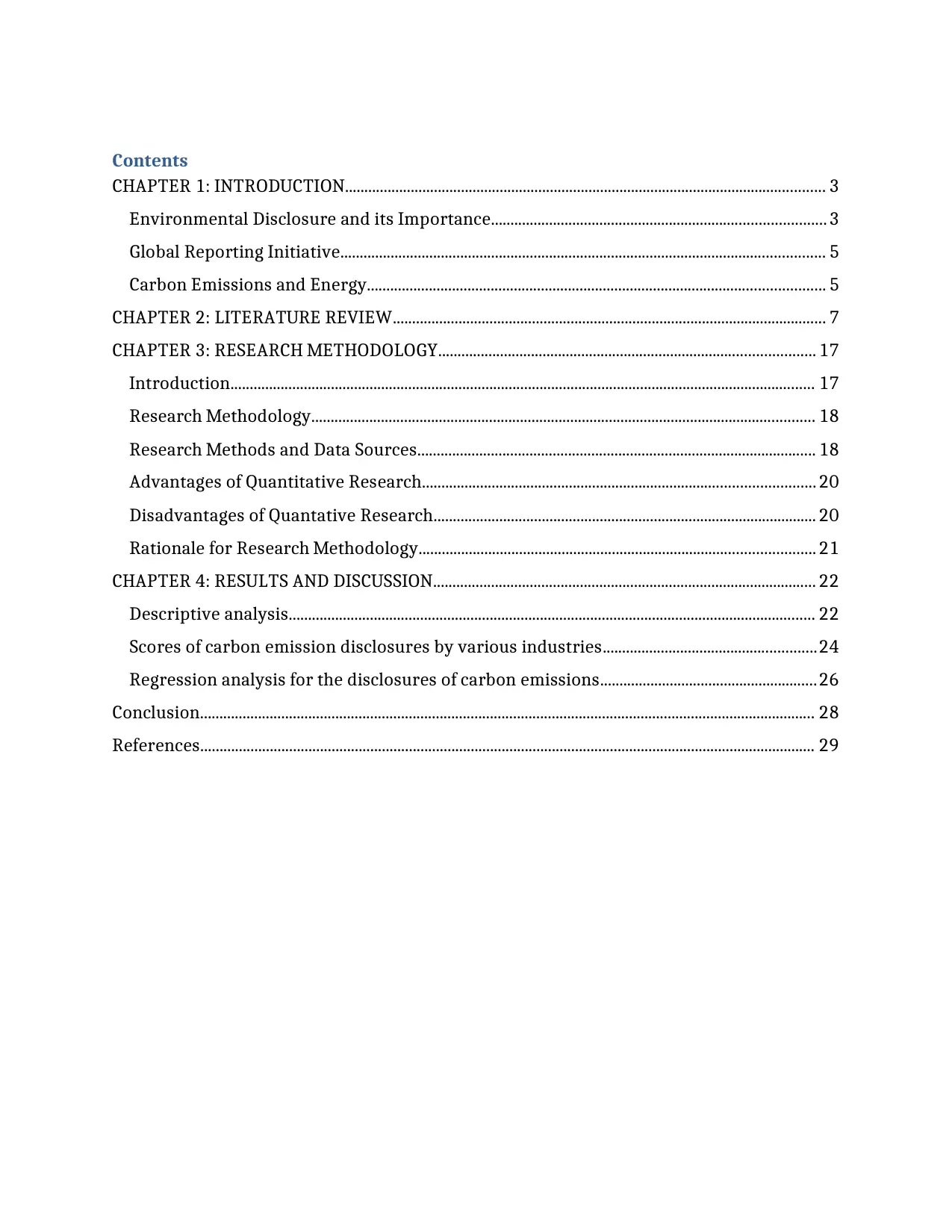
Contents
CHAPTER 1: INTRODUCTION............................................................................................................................ 3
Environmental Disclosure and its Importance...................................................................................... 3
Global Reporting Initiative............................................................................................................................. 5
Carbon Emissions and Energy...................................................................................................................... 5
CHAPTER 2: LITERATURE REVIEW................................................................................................................ 7
CHAPTER 3: RESEARCH METHODOLOGY................................................................................................. 17
Introduction....................................................................................................................................................... 17
Research Methodology.................................................................................................................................. 18
Research Methods and Data Sources....................................................................................................... 18
Advantages of Quantitative Research..................................................................................................... 20
Disadvantages of Quantative Research................................................................................................... 20
Rationale for Research Methodology...................................................................................................... 21
CHAPTER 4: RESULTS AND DISCUSSION................................................................................................... 22
Descriptive analysis........................................................................................................................................ 22
Scores of carbon emission disclosures by various industries.......................................................24
Regression analysis for the disclosures of carbon emissions........................................................26
Conclusion............................................................................................................................................................... 28
References............................................................................................................................................................... 29
CHAPTER 1: INTRODUCTION............................................................................................................................ 3
Environmental Disclosure and its Importance...................................................................................... 3
Global Reporting Initiative............................................................................................................................. 5
Carbon Emissions and Energy...................................................................................................................... 5
CHAPTER 2: LITERATURE REVIEW................................................................................................................ 7
CHAPTER 3: RESEARCH METHODOLOGY................................................................................................. 17
Introduction....................................................................................................................................................... 17
Research Methodology.................................................................................................................................. 18
Research Methods and Data Sources....................................................................................................... 18
Advantages of Quantitative Research..................................................................................................... 20
Disadvantages of Quantative Research................................................................................................... 20
Rationale for Research Methodology...................................................................................................... 21
CHAPTER 4: RESULTS AND DISCUSSION................................................................................................... 22
Descriptive analysis........................................................................................................................................ 22
Scores of carbon emission disclosures by various industries.......................................................24
Regression analysis for the disclosures of carbon emissions........................................................26
Conclusion............................................................................................................................................................... 28
References............................................................................................................................................................... 29

CHAPTER 1: INTRODUCTION
Environmental Disclosure and its Importance
With time, the engagement of a company in CSR issues develops and hence the degree to which
it is in a position to disclose its information. Past research has indicated gradual increases in the
disclosure of CSR in the annual reports of companies. Environmental reporting was first studied
as a segment of social reporting. Different studies have been done regarding corporate socials
reporting as well as environmental reporting. Environmental disclosure can thus be defined as
the disclosing of the information of a company regarding its environmental practices. Such
disclosure may be of benefit to the company and its reputation as compared to the actual
environmental firmly performance as has been proven by a recent study (Haque & Deegan
2010).
The non-anticipated benefit of disclosing information may help lower the incentives of a
company toward improving the environmental performance in the times to come. From the
various analyses done by researchers, it has been demonstrated that the more information is
disclosed by companies with regard to their sustainable practices, the better they were perceived
to be environmentally friendly even under circumstances that the data presented proved
otherwise (Moroney, Windsor & Aw 2012).
With the current business information technology such as the internet accessible equipment and
the tools, the industrial environmental tools of the management, the policies and the legislation
that govern the environmental information has been designed. The information that is obtained
from the environmental information system has been of help to the managers. It has helped the
managers to identify the potential risks, the incurred costs of the structure including the
investment that needs the environmental challenge to be faced by the firm itself.
Environmental Disclosure and its Importance
With time, the engagement of a company in CSR issues develops and hence the degree to which
it is in a position to disclose its information. Past research has indicated gradual increases in the
disclosure of CSR in the annual reports of companies. Environmental reporting was first studied
as a segment of social reporting. Different studies have been done regarding corporate socials
reporting as well as environmental reporting. Environmental disclosure can thus be defined as
the disclosing of the information of a company regarding its environmental practices. Such
disclosure may be of benefit to the company and its reputation as compared to the actual
environmental firmly performance as has been proven by a recent study (Haque & Deegan
2010).
The non-anticipated benefit of disclosing information may help lower the incentives of a
company toward improving the environmental performance in the times to come. From the
various analyses done by researchers, it has been demonstrated that the more information is
disclosed by companies with regard to their sustainable practices, the better they were perceived
to be environmentally friendly even under circumstances that the data presented proved
otherwise (Moroney, Windsor & Aw 2012).
With the current business information technology such as the internet accessible equipment and
the tools, the industrial environmental tools of the management, the policies and the legislation
that govern the environmental information has been designed. The information that is obtained
from the environmental information system has been of help to the managers. It has helped the
managers to identify the potential risks, the incurred costs of the structure including the
investment that needs the environmental challenge to be faced by the firm itself.
⊘ This is a preview!⊘
Do you want full access?
Subscribe today to unlock all pages.

Trusted by 1+ million students worldwide
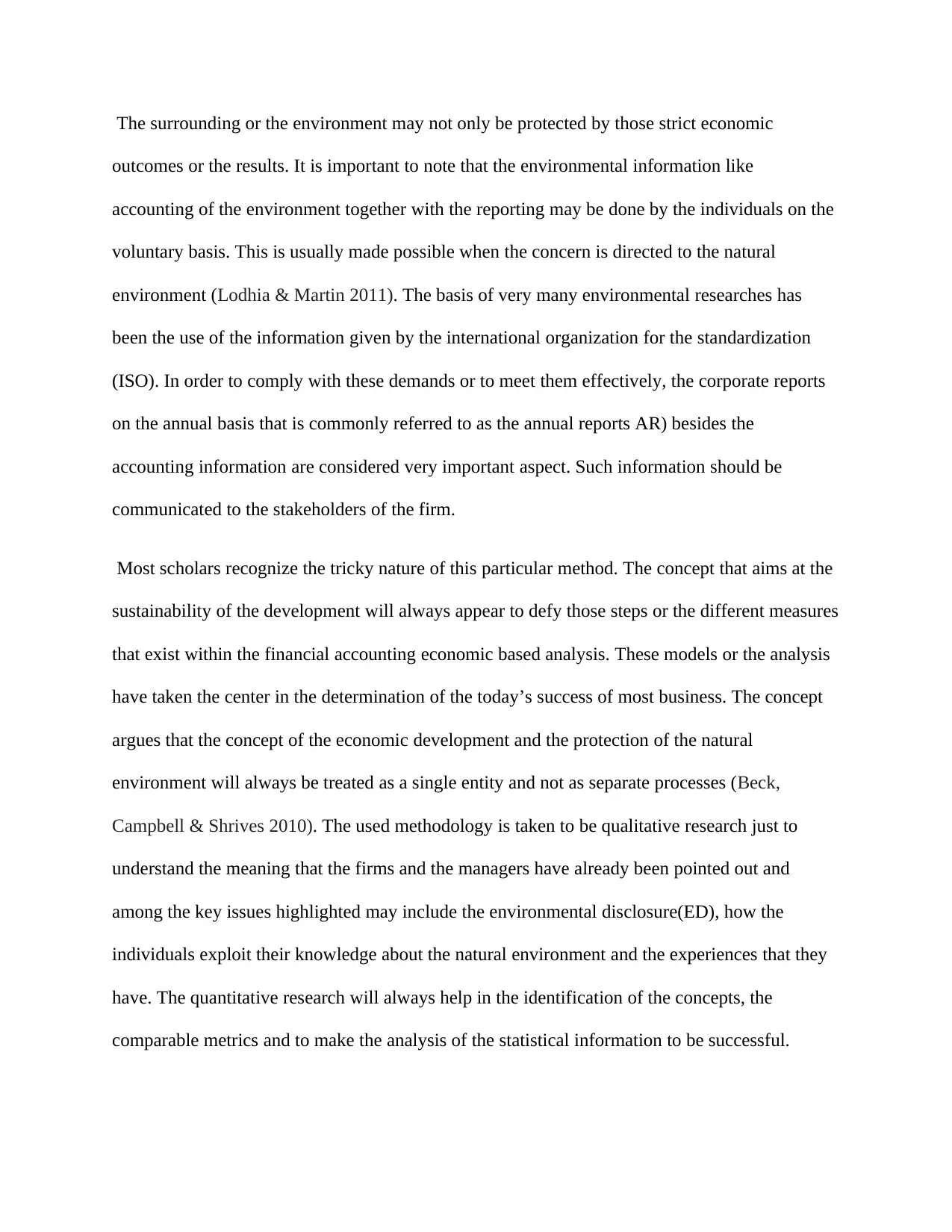
The surrounding or the environment may not only be protected by those strict economic
outcomes or the results. It is important to note that the environmental information like
accounting of the environment together with the reporting may be done by the individuals on the
voluntary basis. This is usually made possible when the concern is directed to the natural
environment (Lodhia & Martin 2011). The basis of very many environmental researches has
been the use of the information given by the international organization for the standardization
(ISO). In order to comply with these demands or to meet them effectively, the corporate reports
on the annual basis that is commonly referred to as the annual reports AR) besides the
accounting information are considered very important aspect. Such information should be
communicated to the stakeholders of the firm.
Most scholars recognize the tricky nature of this particular method. The concept that aims at the
sustainability of the development will always appear to defy those steps or the different measures
that exist within the financial accounting economic based analysis. These models or the analysis
have taken the center in the determination of the today’s success of most business. The concept
argues that the concept of the economic development and the protection of the natural
environment will always be treated as a single entity and not as separate processes (Beck,
Campbell & Shrives 2010). The used methodology is taken to be qualitative research just to
understand the meaning that the firms and the managers have already been pointed out and
among the key issues highlighted may include the environmental disclosure(ED), how the
individuals exploit their knowledge about the natural environment and the experiences that they
have. The quantitative research will always help in the identification of the concepts, the
comparable metrics and to make the analysis of the statistical information to be successful.
outcomes or the results. It is important to note that the environmental information like
accounting of the environment together with the reporting may be done by the individuals on the
voluntary basis. This is usually made possible when the concern is directed to the natural
environment (Lodhia & Martin 2011). The basis of very many environmental researches has
been the use of the information given by the international organization for the standardization
(ISO). In order to comply with these demands or to meet them effectively, the corporate reports
on the annual basis that is commonly referred to as the annual reports AR) besides the
accounting information are considered very important aspect. Such information should be
communicated to the stakeholders of the firm.
Most scholars recognize the tricky nature of this particular method. The concept that aims at the
sustainability of the development will always appear to defy those steps or the different measures
that exist within the financial accounting economic based analysis. These models or the analysis
have taken the center in the determination of the today’s success of most business. The concept
argues that the concept of the economic development and the protection of the natural
environment will always be treated as a single entity and not as separate processes (Beck,
Campbell & Shrives 2010). The used methodology is taken to be qualitative research just to
understand the meaning that the firms and the managers have already been pointed out and
among the key issues highlighted may include the environmental disclosure(ED), how the
individuals exploit their knowledge about the natural environment and the experiences that they
have. The quantitative research will always help in the identification of the concepts, the
comparable metrics and to make the analysis of the statistical information to be successful.
Paraphrase This Document
Need a fresh take? Get an instant paraphrase of this document with our AI Paraphraser
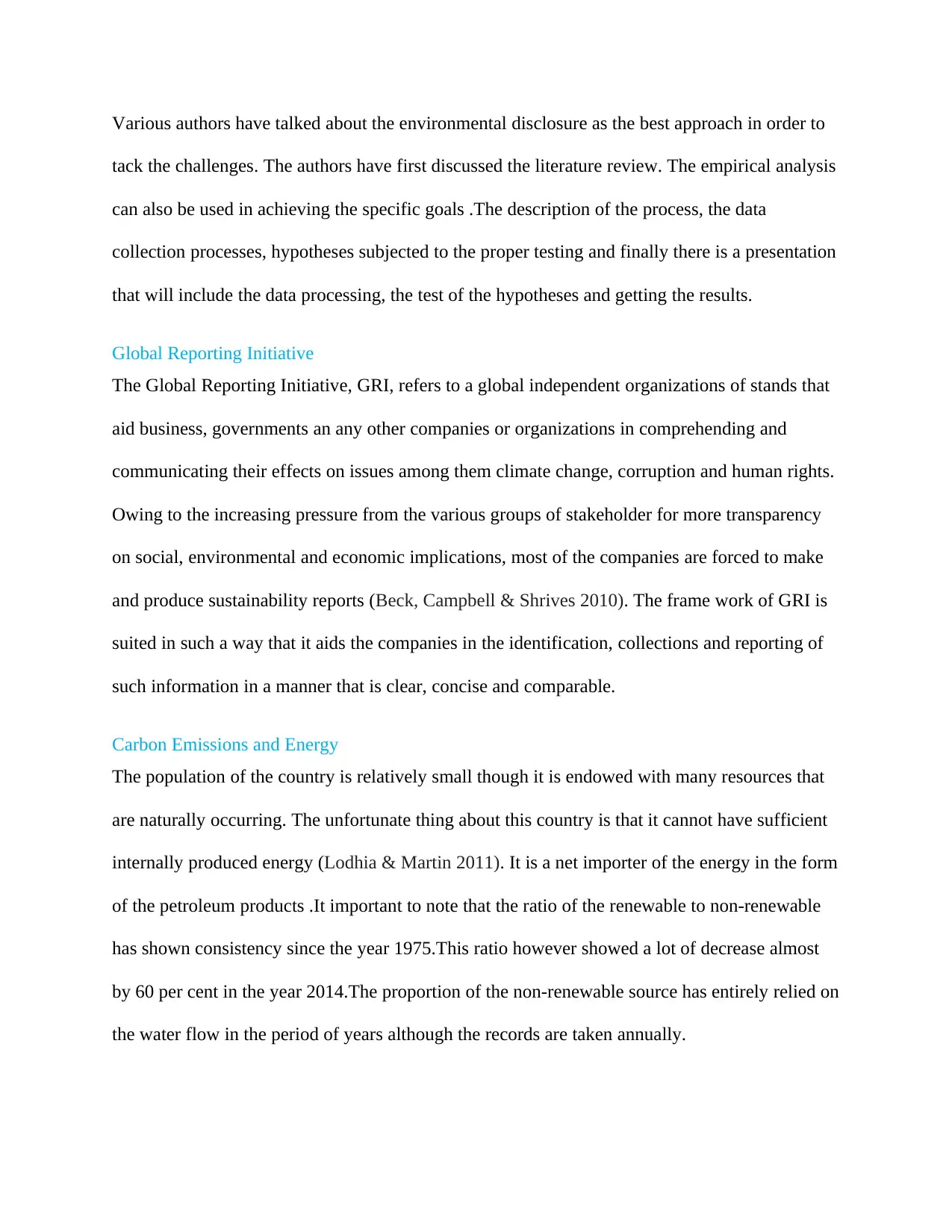
Various authors have talked about the environmental disclosure as the best approach in order to
tack the challenges. The authors have first discussed the literature review. The empirical analysis
can also be used in achieving the specific goals .The description of the process, the data
collection processes, hypotheses subjected to the proper testing and finally there is a presentation
that will include the data processing, the test of the hypotheses and getting the results.
Global Reporting Initiative
The Global Reporting Initiative, GRI, refers to a global independent organizations of stands that
aid business, governments an any other companies or organizations in comprehending and
communicating their effects on issues among them climate change, corruption and human rights.
Owing to the increasing pressure from the various groups of stakeholder for more transparency
on social, environmental and economic implications, most of the companies are forced to make
and produce sustainability reports (Beck, Campbell & Shrives 2010). The frame work of GRI is
suited in such a way that it aids the companies in the identification, collections and reporting of
such information in a manner that is clear, concise and comparable.
Carbon Emissions and Energy
The population of the country is relatively small though it is endowed with many resources that
are naturally occurring. The unfortunate thing about this country is that it cannot have sufficient
internally produced energy (Lodhia & Martin 2011). It is a net importer of the energy in the form
of the petroleum products .It important to note that the ratio of the renewable to non-renewable
has shown consistency since the year 1975.This ratio however showed a lot of decrease almost
by 60 per cent in the year 2014.The proportion of the non-renewable source has entirely relied on
the water flow in the period of years although the records are taken annually.
tack the challenges. The authors have first discussed the literature review. The empirical analysis
can also be used in achieving the specific goals .The description of the process, the data
collection processes, hypotheses subjected to the proper testing and finally there is a presentation
that will include the data processing, the test of the hypotheses and getting the results.
Global Reporting Initiative
The Global Reporting Initiative, GRI, refers to a global independent organizations of stands that
aid business, governments an any other companies or organizations in comprehending and
communicating their effects on issues among them climate change, corruption and human rights.
Owing to the increasing pressure from the various groups of stakeholder for more transparency
on social, environmental and economic implications, most of the companies are forced to make
and produce sustainability reports (Beck, Campbell & Shrives 2010). The frame work of GRI is
suited in such a way that it aids the companies in the identification, collections and reporting of
such information in a manner that is clear, concise and comparable.
Carbon Emissions and Energy
The population of the country is relatively small though it is endowed with many resources that
are naturally occurring. The unfortunate thing about this country is that it cannot have sufficient
internally produced energy (Lodhia & Martin 2011). It is a net importer of the energy in the form
of the petroleum products .It important to note that the ratio of the renewable to non-renewable
has shown consistency since the year 1975.This ratio however showed a lot of decrease almost
by 60 per cent in the year 2014.The proportion of the non-renewable source has entirely relied on
the water flow in the period of years although the records are taken annually.
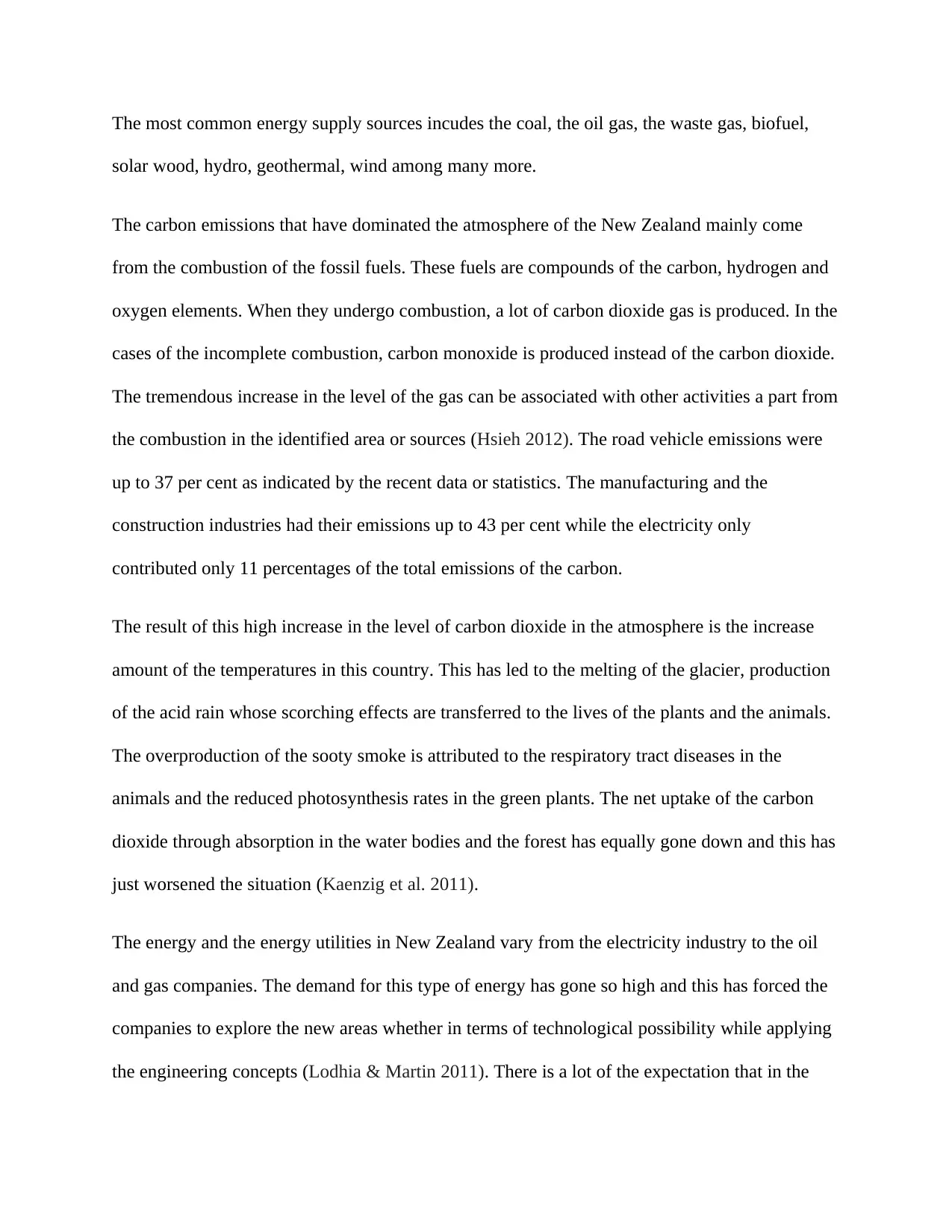
The most common energy supply sources incudes the coal, the oil gas, the waste gas, biofuel,
solar wood, hydro, geothermal, wind among many more.
The carbon emissions that have dominated the atmosphere of the New Zealand mainly come
from the combustion of the fossil fuels. These fuels are compounds of the carbon, hydrogen and
oxygen elements. When they undergo combustion, a lot of carbon dioxide gas is produced. In the
cases of the incomplete combustion, carbon monoxide is produced instead of the carbon dioxide.
The tremendous increase in the level of the gas can be associated with other activities a part from
the combustion in the identified area or sources (Hsieh 2012). The road vehicle emissions were
up to 37 per cent as indicated by the recent data or statistics. The manufacturing and the
construction industries had their emissions up to 43 per cent while the electricity only
contributed only 11 percentages of the total emissions of the carbon.
The result of this high increase in the level of carbon dioxide in the atmosphere is the increase
amount of the temperatures in this country. This has led to the melting of the glacier, production
of the acid rain whose scorching effects are transferred to the lives of the plants and the animals.
The overproduction of the sooty smoke is attributed to the respiratory tract diseases in the
animals and the reduced photosynthesis rates in the green plants. The net uptake of the carbon
dioxide through absorption in the water bodies and the forest has equally gone down and this has
just worsened the situation (Kaenzig et al. 2011).
The energy and the energy utilities in New Zealand vary from the electricity industry to the oil
and gas companies. The demand for this type of energy has gone so high and this has forced the
companies to explore the new areas whether in terms of technological possibility while applying
the engineering concepts (Lodhia & Martin 2011). There is a lot of the expectation that in the
solar wood, hydro, geothermal, wind among many more.
The carbon emissions that have dominated the atmosphere of the New Zealand mainly come
from the combustion of the fossil fuels. These fuels are compounds of the carbon, hydrogen and
oxygen elements. When they undergo combustion, a lot of carbon dioxide gas is produced. In the
cases of the incomplete combustion, carbon monoxide is produced instead of the carbon dioxide.
The tremendous increase in the level of the gas can be associated with other activities a part from
the combustion in the identified area or sources (Hsieh 2012). The road vehicle emissions were
up to 37 per cent as indicated by the recent data or statistics. The manufacturing and the
construction industries had their emissions up to 43 per cent while the electricity only
contributed only 11 percentages of the total emissions of the carbon.
The result of this high increase in the level of carbon dioxide in the atmosphere is the increase
amount of the temperatures in this country. This has led to the melting of the glacier, production
of the acid rain whose scorching effects are transferred to the lives of the plants and the animals.
The overproduction of the sooty smoke is attributed to the respiratory tract diseases in the
animals and the reduced photosynthesis rates in the green plants. The net uptake of the carbon
dioxide through absorption in the water bodies and the forest has equally gone down and this has
just worsened the situation (Kaenzig et al. 2011).
The energy and the energy utilities in New Zealand vary from the electricity industry to the oil
and gas companies. The demand for this type of energy has gone so high and this has forced the
companies to explore the new areas whether in terms of technological possibility while applying
the engineering concepts (Lodhia & Martin 2011). There is a lot of the expectation that in the
⊘ This is a preview!⊘
Do you want full access?
Subscribe today to unlock all pages.

Trusted by 1+ million students worldwide
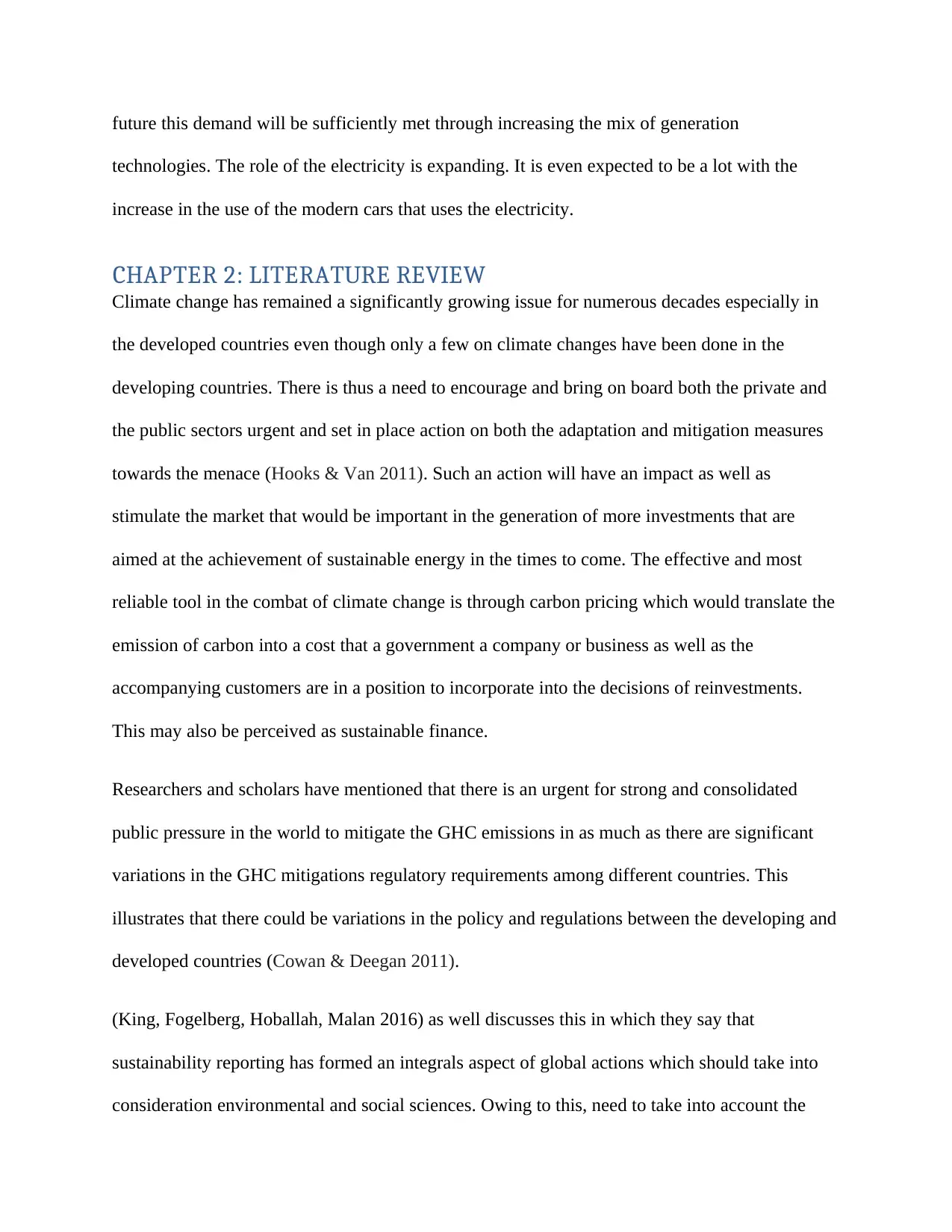
future this demand will be sufficiently met through increasing the mix of generation
technologies. The role of the electricity is expanding. It is even expected to be a lot with the
increase in the use of the modern cars that uses the electricity.
CHAPTER 2: LITERATURE REVIEW
Climate change has remained a significantly growing issue for numerous decades especially in
the developed countries even though only a few on climate changes have been done in the
developing countries. There is thus a need to encourage and bring on board both the private and
the public sectors urgent and set in place action on both the adaptation and mitigation measures
towards the menace (Hooks & Van 2011). Such an action will have an impact as well as
stimulate the market that would be important in the generation of more investments that are
aimed at the achievement of sustainable energy in the times to come. The effective and most
reliable tool in the combat of climate change is through carbon pricing which would translate the
emission of carbon into a cost that a government a company or business as well as the
accompanying customers are in a position to incorporate into the decisions of reinvestments.
This may also be perceived as sustainable finance.
Researchers and scholars have mentioned that there is an urgent for strong and consolidated
public pressure in the world to mitigate the GHC emissions in as much as there are significant
variations in the GHC mitigations regulatory requirements among different countries. This
illustrates that there could be variations in the policy and regulations between the developing and
developed countries (Cowan & Deegan 2011).
(King, Fogelberg, Hoballah, Malan 2016) as well discusses this in which they say that
sustainability reporting has formed an integrals aspect of global actions which should take into
consideration environmental and social sciences. Owing to this, need to take into account the
technologies. The role of the electricity is expanding. It is even expected to be a lot with the
increase in the use of the modern cars that uses the electricity.
CHAPTER 2: LITERATURE REVIEW
Climate change has remained a significantly growing issue for numerous decades especially in
the developed countries even though only a few on climate changes have been done in the
developing countries. There is thus a need to encourage and bring on board both the private and
the public sectors urgent and set in place action on both the adaptation and mitigation measures
towards the menace (Hooks & Van 2011). Such an action will have an impact as well as
stimulate the market that would be important in the generation of more investments that are
aimed at the achievement of sustainable energy in the times to come. The effective and most
reliable tool in the combat of climate change is through carbon pricing which would translate the
emission of carbon into a cost that a government a company or business as well as the
accompanying customers are in a position to incorporate into the decisions of reinvestments.
This may also be perceived as sustainable finance.
Researchers and scholars have mentioned that there is an urgent for strong and consolidated
public pressure in the world to mitigate the GHC emissions in as much as there are significant
variations in the GHC mitigations regulatory requirements among different countries. This
illustrates that there could be variations in the policy and regulations between the developing and
developed countries (Cowan & Deegan 2011).
(King, Fogelberg, Hoballah, Malan 2016) as well discusses this in which they say that
sustainability reporting has formed an integrals aspect of global actions which should take into
consideration environmental and social sciences. Owing to this, need to take into account the
Paraphrase This Document
Need a fresh take? Get an instant paraphrase of this document with our AI Paraphraser
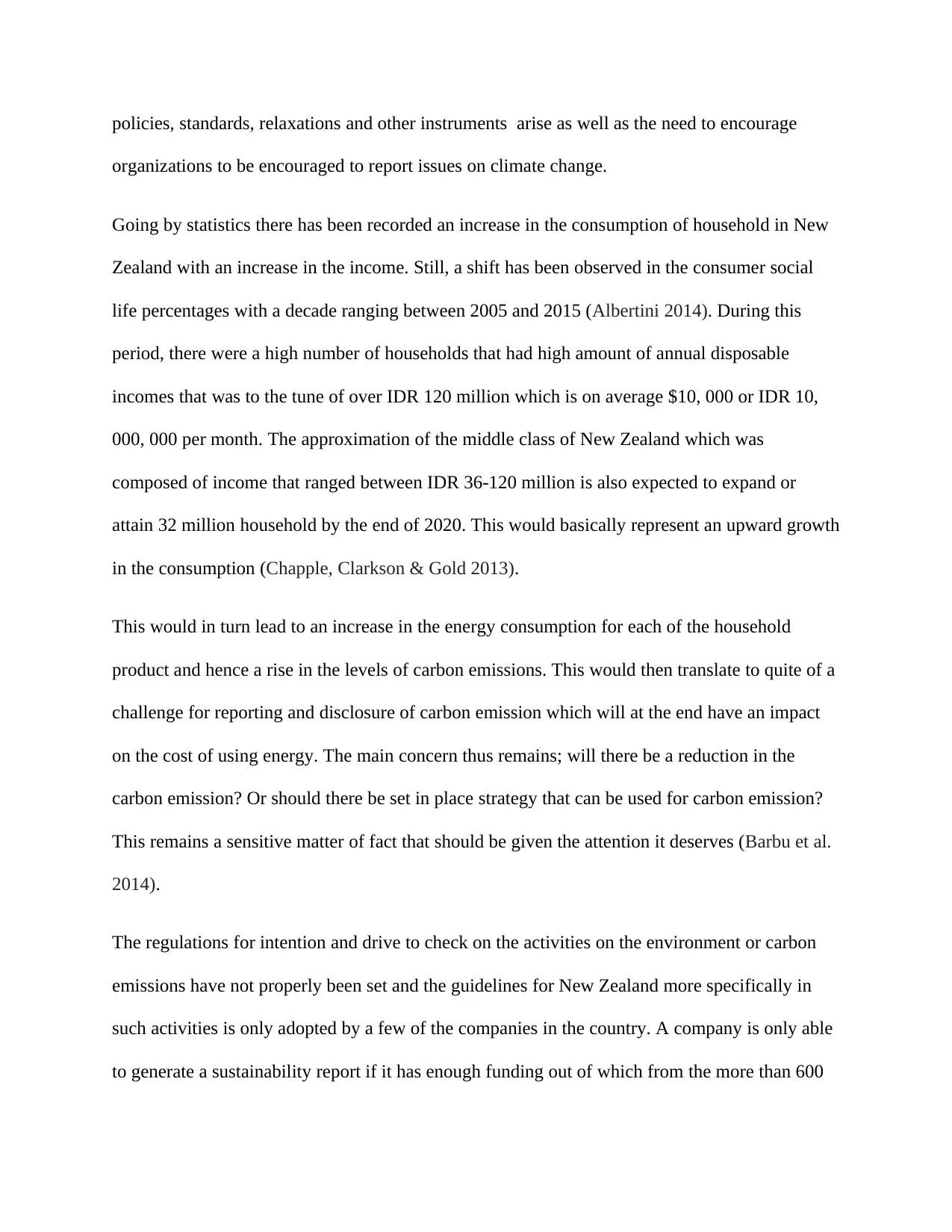
policies, standards, relaxations and other instruments arise as well as the need to encourage
organizations to be encouraged to report issues on climate change.
Going by statistics there has been recorded an increase in the consumption of household in New
Zealand with an increase in the income. Still, a shift has been observed in the consumer social
life percentages with a decade ranging between 2005 and 2015 (Albertini 2014). During this
period, there were a high number of households that had high amount of annual disposable
incomes that was to the tune of over IDR 120 million which is on average $10, 000 or IDR 10,
000, 000 per month. The approximation of the middle class of New Zealand which was
composed of income that ranged between IDR 36-120 million is also expected to expand or
attain 32 million household by the end of 2020. This would basically represent an upward growth
in the consumption (Chapple, Clarkson & Gold 2013).
This would in turn lead to an increase in the energy consumption for each of the household
product and hence a rise in the levels of carbon emissions. This would then translate to quite of a
challenge for reporting and disclosure of carbon emission which will at the end have an impact
on the cost of using energy. The main concern thus remains; will there be a reduction in the
carbon emission? Or should there be set in place strategy that can be used for carbon emission?
This remains a sensitive matter of fact that should be given the attention it deserves (Barbu et al.
2014).
The regulations for intention and drive to check on the activities on the environment or carbon
emissions have not properly been set and the guidelines for New Zealand more specifically in
such activities is only adopted by a few of the companies in the country. A company is only able
to generate a sustainability report if it has enough funding out of which from the more than 600
organizations to be encouraged to report issues on climate change.
Going by statistics there has been recorded an increase in the consumption of household in New
Zealand with an increase in the income. Still, a shift has been observed in the consumer social
life percentages with a decade ranging between 2005 and 2015 (Albertini 2014). During this
period, there were a high number of households that had high amount of annual disposable
incomes that was to the tune of over IDR 120 million which is on average $10, 000 or IDR 10,
000, 000 per month. The approximation of the middle class of New Zealand which was
composed of income that ranged between IDR 36-120 million is also expected to expand or
attain 32 million household by the end of 2020. This would basically represent an upward growth
in the consumption (Chapple, Clarkson & Gold 2013).
This would in turn lead to an increase in the energy consumption for each of the household
product and hence a rise in the levels of carbon emissions. This would then translate to quite of a
challenge for reporting and disclosure of carbon emission which will at the end have an impact
on the cost of using energy. The main concern thus remains; will there be a reduction in the
carbon emission? Or should there be set in place strategy that can be used for carbon emission?
This remains a sensitive matter of fact that should be given the attention it deserves (Barbu et al.
2014).
The regulations for intention and drive to check on the activities on the environment or carbon
emissions have not properly been set and the guidelines for New Zealand more specifically in
such activities is only adopted by a few of the companies in the country. A company is only able
to generate a sustainability report if it has enough funding out of which from the more than 600

companies available, just about 100 of them make and produce the sustainability report (Hubbard
2011). This can be taken to illustrate that this is more of a voluntary reporting. Should it be set in
such a way that it is mandatory with a penalty being levied on defaulter by the government, then
most of the companies in the countries if not all will be producing reports on sustainability and
disclosing them to the general public.
The next matter that deserves equal consideration is funding of the constraint. After the problem
has elaborately been explained, disclosed and reported, the need to report is thus explored. This
revolves around understanding the need of companies or organizing reporting and disclosing.
Discussions of GRI 4 and GRI standard extended just provide information on how to
environmentally report but instead does not categorically talk about carbon emission (Moroney,
Windsor & Aw 2012). This then translates to the lack of a formal channel that is concerned with
carbon emission in New Zealand. To add on this list of concern is the lack of information on
New Zealand companies’ inclusion in the GDP.
Researchers conducting research in the factors or determinant of environmental disclosure which
offer consideration to the type of industry, the size of the firm as well as its profitability list
Dutch listed companies as these that belong to developed countries. From their findings, they are
able to authoritative make a conclusion that they type of industry and the size of the firm have a
major role to play when it comes to environmental disclosure (Sprengel & Busch 2011). In their
findings, they also establish that there is no significant correlation between profitability and
environmental disclosure. The basis of their argument is borrowing from data extracted from
conditions of financial crisis which may the case where a company has a debt or is suffering
from financial distress.
2011). This can be taken to illustrate that this is more of a voluntary reporting. Should it be set in
such a way that it is mandatory with a penalty being levied on defaulter by the government, then
most of the companies in the countries if not all will be producing reports on sustainability and
disclosing them to the general public.
The next matter that deserves equal consideration is funding of the constraint. After the problem
has elaborately been explained, disclosed and reported, the need to report is thus explored. This
revolves around understanding the need of companies or organizing reporting and disclosing.
Discussions of GRI 4 and GRI standard extended just provide information on how to
environmentally report but instead does not categorically talk about carbon emission (Moroney,
Windsor & Aw 2012). This then translates to the lack of a formal channel that is concerned with
carbon emission in New Zealand. To add on this list of concern is the lack of information on
New Zealand companies’ inclusion in the GDP.
Researchers conducting research in the factors or determinant of environmental disclosure which
offer consideration to the type of industry, the size of the firm as well as its profitability list
Dutch listed companies as these that belong to developed countries. From their findings, they are
able to authoritative make a conclusion that they type of industry and the size of the firm have a
major role to play when it comes to environmental disclosure (Sprengel & Busch 2011). In their
findings, they also establish that there is no significant correlation between profitability and
environmental disclosure. The basis of their argument is borrowing from data extracted from
conditions of financial crisis which may the case where a company has a debt or is suffering
from financial distress.
⊘ This is a preview!⊘
Do you want full access?
Subscribe today to unlock all pages.

Trusted by 1+ million students worldwide
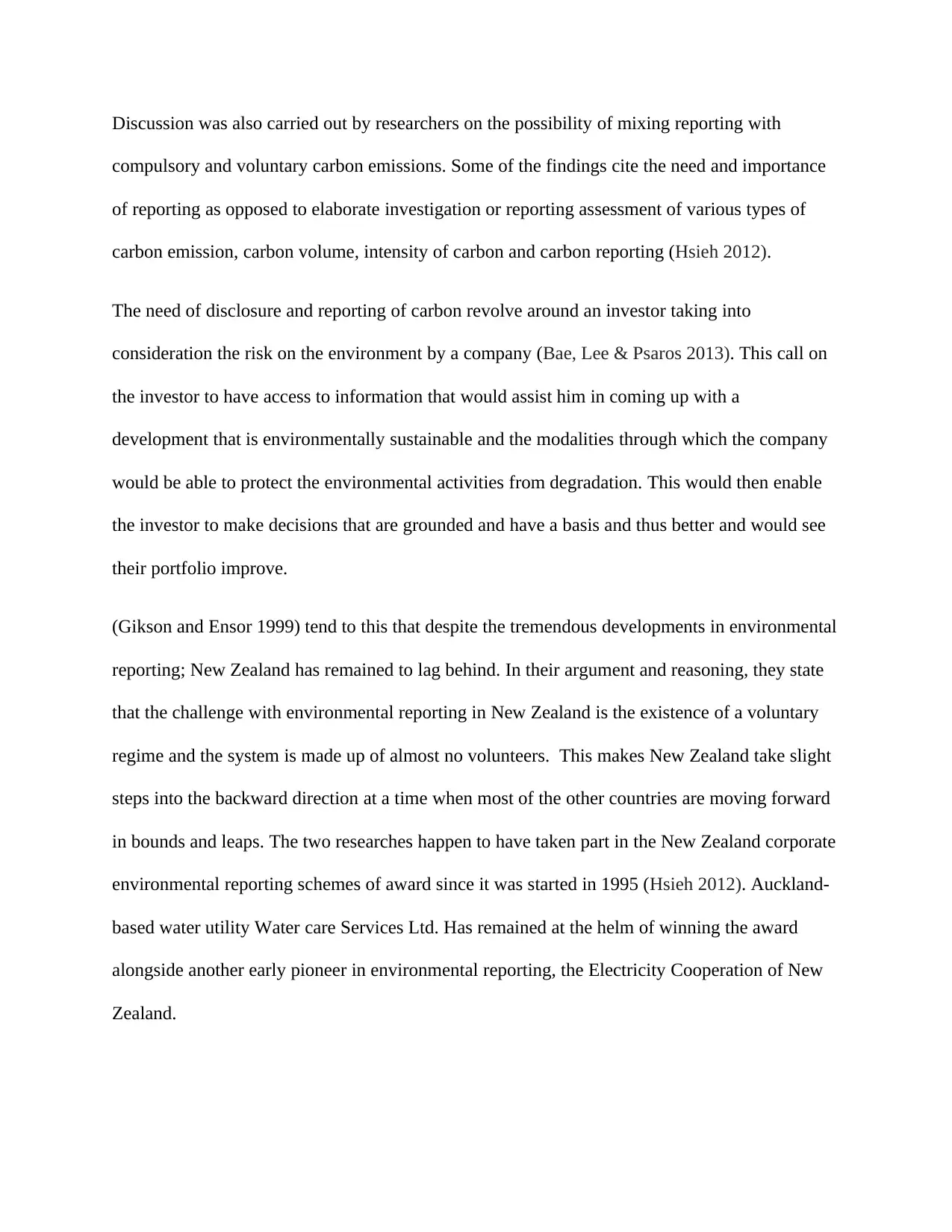
Discussion was also carried out by researchers on the possibility of mixing reporting with
compulsory and voluntary carbon emissions. Some of the findings cite the need and importance
of reporting as opposed to elaborate investigation or reporting assessment of various types of
carbon emission, carbon volume, intensity of carbon and carbon reporting (Hsieh 2012).
The need of disclosure and reporting of carbon revolve around an investor taking into
consideration the risk on the environment by a company (Bae, Lee & Psaros 2013). This call on
the investor to have access to information that would assist him in coming up with a
development that is environmentally sustainable and the modalities through which the company
would be able to protect the environmental activities from degradation. This would then enable
the investor to make decisions that are grounded and have a basis and thus better and would see
their portfolio improve.
(Gikson and Ensor 1999) tend to this that despite the tremendous developments in environmental
reporting; New Zealand has remained to lag behind. In their argument and reasoning, they state
that the challenge with environmental reporting in New Zealand is the existence of a voluntary
regime and the system is made up of almost no volunteers. This makes New Zealand take slight
steps into the backward direction at a time when most of the other countries are moving forward
in bounds and leaps. The two researches happen to have taken part in the New Zealand corporate
environmental reporting schemes of award since it was started in 1995 (Hsieh 2012). Auckland-
based water utility Water care Services Ltd. Has remained at the helm of winning the award
alongside another early pioneer in environmental reporting, the Electricity Cooperation of New
Zealand.
compulsory and voluntary carbon emissions. Some of the findings cite the need and importance
of reporting as opposed to elaborate investigation or reporting assessment of various types of
carbon emission, carbon volume, intensity of carbon and carbon reporting (Hsieh 2012).
The need of disclosure and reporting of carbon revolve around an investor taking into
consideration the risk on the environment by a company (Bae, Lee & Psaros 2013). This call on
the investor to have access to information that would assist him in coming up with a
development that is environmentally sustainable and the modalities through which the company
would be able to protect the environmental activities from degradation. This would then enable
the investor to make decisions that are grounded and have a basis and thus better and would see
their portfolio improve.
(Gikson and Ensor 1999) tend to this that despite the tremendous developments in environmental
reporting; New Zealand has remained to lag behind. In their argument and reasoning, they state
that the challenge with environmental reporting in New Zealand is the existence of a voluntary
regime and the system is made up of almost no volunteers. This makes New Zealand take slight
steps into the backward direction at a time when most of the other countries are moving forward
in bounds and leaps. The two researches happen to have taken part in the New Zealand corporate
environmental reporting schemes of award since it was started in 1995 (Hsieh 2012). Auckland-
based water utility Water care Services Ltd. Has remained at the helm of winning the award
alongside another early pioneer in environmental reporting, the Electricity Cooperation of New
Zealand.
Paraphrase This Document
Need a fresh take? Get an instant paraphrase of this document with our AI Paraphraser
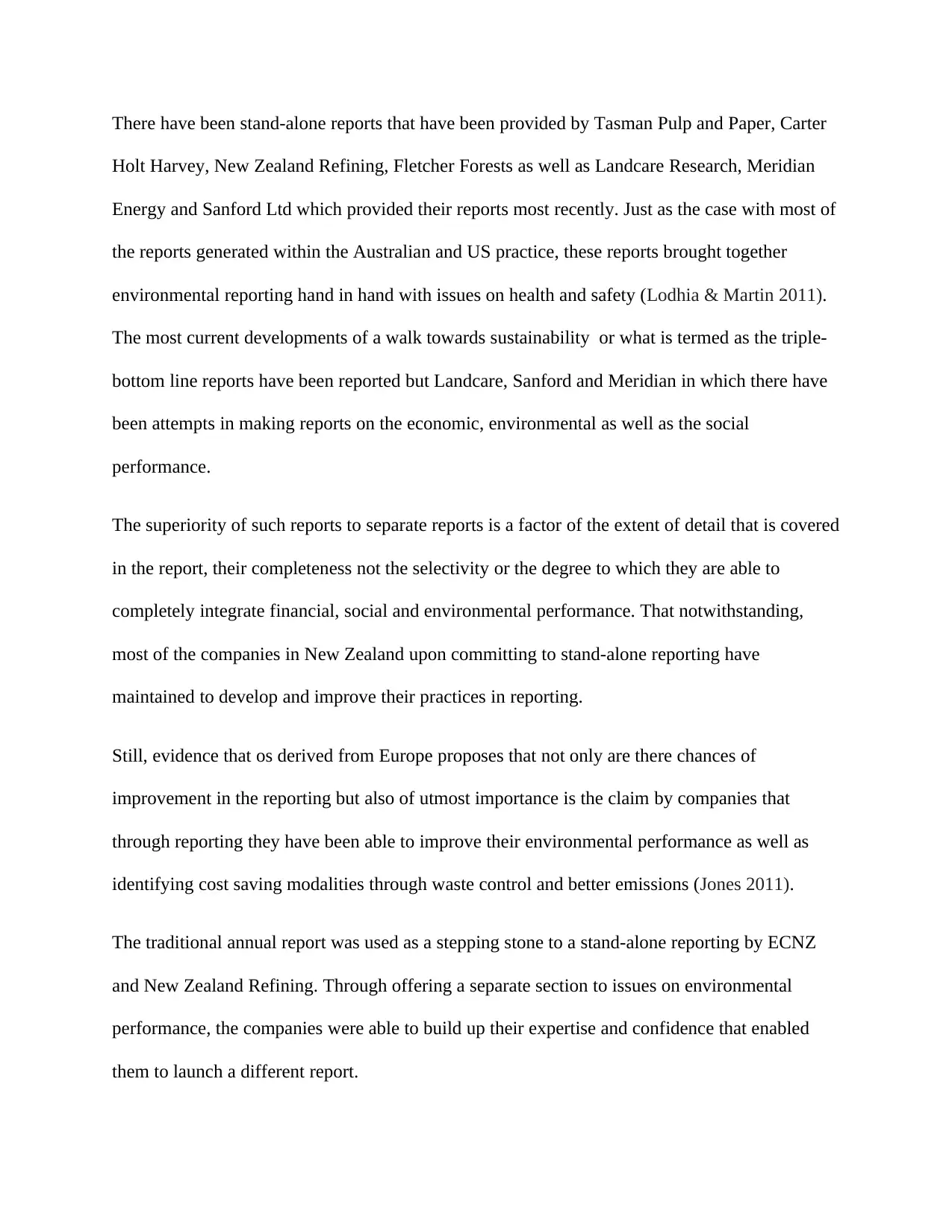
There have been stand-alone reports that have been provided by Tasman Pulp and Paper, Carter
Holt Harvey, New Zealand Refining, Fletcher Forests as well as Landcare Research, Meridian
Energy and Sanford Ltd which provided their reports most recently. Just as the case with most of
the reports generated within the Australian and US practice, these reports brought together
environmental reporting hand in hand with issues on health and safety (Lodhia & Martin 2011).
The most current developments of a walk towards sustainability or what is termed as the triple-
bottom line reports have been reported but Landcare, Sanford and Meridian in which there have
been attempts in making reports on the economic, environmental as well as the social
performance.
The superiority of such reports to separate reports is a factor of the extent of detail that is covered
in the report, their completeness not the selectivity or the degree to which they are able to
completely integrate financial, social and environmental performance. That notwithstanding,
most of the companies in New Zealand upon committing to stand-alone reporting have
maintained to develop and improve their practices in reporting.
Still, evidence that os derived from Europe proposes that not only are there chances of
improvement in the reporting but also of utmost importance is the claim by companies that
through reporting they have been able to improve their environmental performance as well as
identifying cost saving modalities through waste control and better emissions (Jones 2011).
The traditional annual report was used as a stepping stone to a stand-alone reporting by ECNZ
and New Zealand Refining. Through offering a separate section to issues on environmental
performance, the companies were able to build up their expertise and confidence that enabled
them to launch a different report.
Holt Harvey, New Zealand Refining, Fletcher Forests as well as Landcare Research, Meridian
Energy and Sanford Ltd which provided their reports most recently. Just as the case with most of
the reports generated within the Australian and US practice, these reports brought together
environmental reporting hand in hand with issues on health and safety (Lodhia & Martin 2011).
The most current developments of a walk towards sustainability or what is termed as the triple-
bottom line reports have been reported but Landcare, Sanford and Meridian in which there have
been attempts in making reports on the economic, environmental as well as the social
performance.
The superiority of such reports to separate reports is a factor of the extent of detail that is covered
in the report, their completeness not the selectivity or the degree to which they are able to
completely integrate financial, social and environmental performance. That notwithstanding,
most of the companies in New Zealand upon committing to stand-alone reporting have
maintained to develop and improve their practices in reporting.
Still, evidence that os derived from Europe proposes that not only are there chances of
improvement in the reporting but also of utmost importance is the claim by companies that
through reporting they have been able to improve their environmental performance as well as
identifying cost saving modalities through waste control and better emissions (Jones 2011).
The traditional annual report was used as a stepping stone to a stand-alone reporting by ECNZ
and New Zealand Refining. Through offering a separate section to issues on environmental
performance, the companies were able to build up their expertise and confidence that enabled
them to launch a different report.
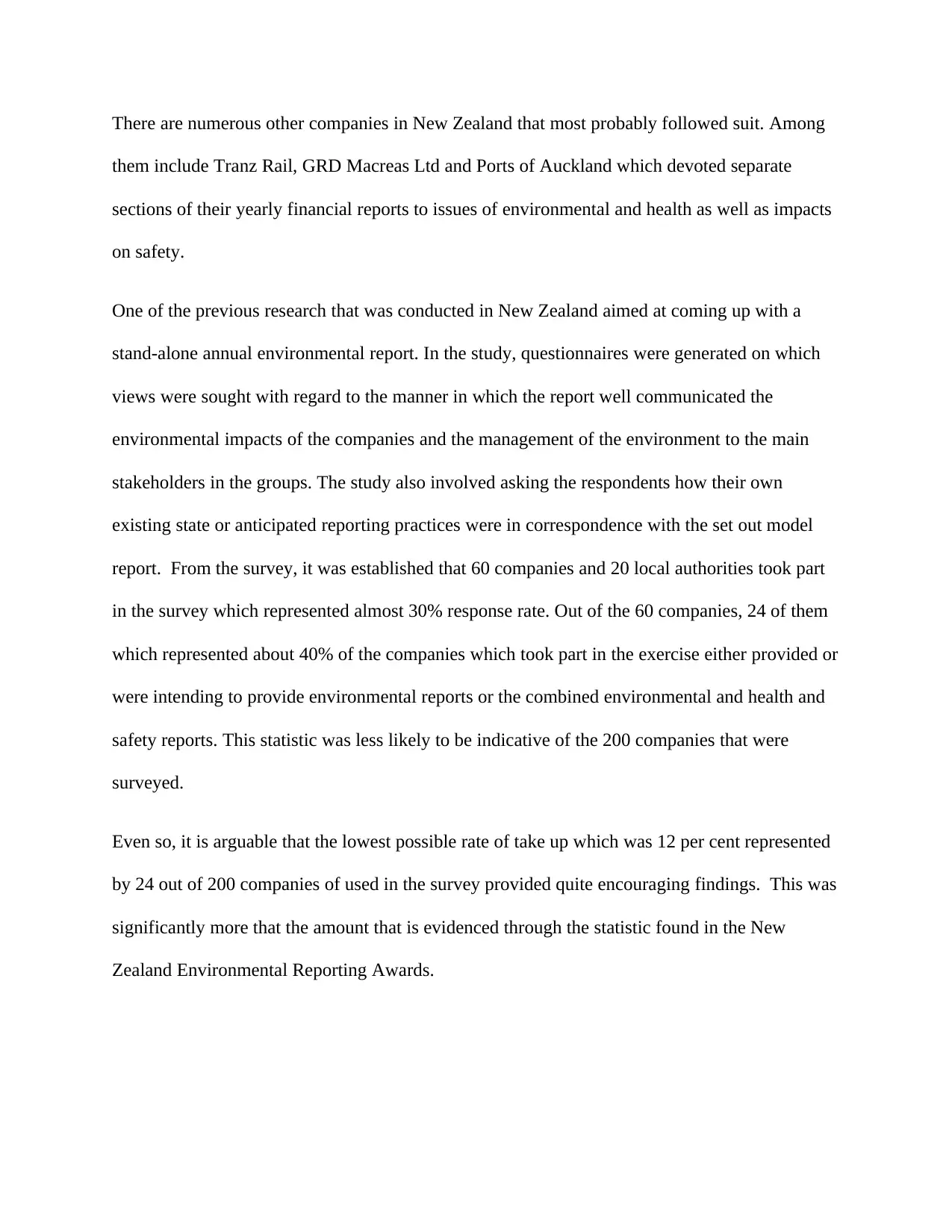
There are numerous other companies in New Zealand that most probably followed suit. Among
them include Tranz Rail, GRD Macreas Ltd and Ports of Auckland which devoted separate
sections of their yearly financial reports to issues of environmental and health as well as impacts
on safety.
One of the previous research that was conducted in New Zealand aimed at coming up with a
stand-alone annual environmental report. In the study, questionnaires were generated on which
views were sought with regard to the manner in which the report well communicated the
environmental impacts of the companies and the management of the environment to the main
stakeholders in the groups. The study also involved asking the respondents how their own
existing state or anticipated reporting practices were in correspondence with the set out model
report. From the survey, it was established that 60 companies and 20 local authorities took part
in the survey which represented almost 30% response rate. Out of the 60 companies, 24 of them
which represented about 40% of the companies which took part in the exercise either provided or
were intending to provide environmental reports or the combined environmental and health and
safety reports. This statistic was less likely to be indicative of the 200 companies that were
surveyed.
Even so, it is arguable that the lowest possible rate of take up which was 12 per cent represented
by 24 out of 200 companies of used in the survey provided quite encouraging findings. This was
significantly more that the amount that is evidenced through the statistic found in the New
Zealand Environmental Reporting Awards.
them include Tranz Rail, GRD Macreas Ltd and Ports of Auckland which devoted separate
sections of their yearly financial reports to issues of environmental and health as well as impacts
on safety.
One of the previous research that was conducted in New Zealand aimed at coming up with a
stand-alone annual environmental report. In the study, questionnaires were generated on which
views were sought with regard to the manner in which the report well communicated the
environmental impacts of the companies and the management of the environment to the main
stakeholders in the groups. The study also involved asking the respondents how their own
existing state or anticipated reporting practices were in correspondence with the set out model
report. From the survey, it was established that 60 companies and 20 local authorities took part
in the survey which represented almost 30% response rate. Out of the 60 companies, 24 of them
which represented about 40% of the companies which took part in the exercise either provided or
were intending to provide environmental reports or the combined environmental and health and
safety reports. This statistic was less likely to be indicative of the 200 companies that were
surveyed.
Even so, it is arguable that the lowest possible rate of take up which was 12 per cent represented
by 24 out of 200 companies of used in the survey provided quite encouraging findings. This was
significantly more that the amount that is evidenced through the statistic found in the New
Zealand Environmental Reporting Awards.
⊘ This is a preview!⊘
Do you want full access?
Subscribe today to unlock all pages.

Trusted by 1+ million students worldwide
1 out of 32
Related Documents
Your All-in-One AI-Powered Toolkit for Academic Success.
+13062052269
info@desklib.com
Available 24*7 on WhatsApp / Email
![[object Object]](/_next/static/media/star-bottom.7253800d.svg)
Unlock your academic potential
Copyright © 2020–2025 A2Z Services. All Rights Reserved. Developed and managed by ZUCOL.





